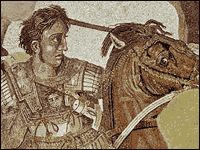|
More on Alexander the Great, archery, and ancient metallurgy
Alexander is well represented on the Web. Here are some sites you might want to visit.
|

Alexander and Bucephalas. This is a section of a mosaic
from the House of the Faun, Pompeii, ca. 80 B.C.
National Archaeologic Museum, Naples, Italy.
Click here for a larger image.
|
- Alexander the Great
This can only be called a fan site. It's a labor of love
created by one guy and a group of volunteers he has been gathering
since 1994. There's lots of information here for anyone, at any
level of interest. Highly recommended.
One article on the site that I found especially interesting:
- Pothos
This is a look at Alexander's personality using the concept
of "pothos" as the defining element of his character. Pothos is
a Greek word for an emotion or state-of-mind that combines desire,
longing for, want, and regret.
- Alexander The Great
A great summary of his life and legacy. It includes a very
detailed timeline.
There's even a special page devoted to Alexander's beloved horse Bucephalas.
- Alexander the Great of Macedon
A summary of Alexander's life in an easy-to-read and
graphically-pleasing manner. If it's graphics you want, don't
miss the tremendous collection of portraits they've put together.
- Alexander by Plutarch
The full text of Plutarch's famous biography, as translated by John Dryden. If you'd prefer it, there's also a more readable version of Plutarch's text, chopped down and loosely
translated into colloquial English.
- In Search of Alexander's Tomb
"The life and times of Alexander the Great make for
fascinating reading, even in modern times. Not only have they
excited the imagination of many, but they have also triggered
expeditions in search of his tomb ...."
This Web site is an account of "the adventures of the
king's remains from Babylon to their final resting place in
Alexandria."
- Sagacious nuggets of Yoda-isms
|

Yoda.
|
Three selected scripts from "Star Wars" movies that
feature the wise Jedi Knight Yoda. What the heck are these
doing here? Only one reason, of course:
Yoda: "Help you I can. Yes, mmmm."
Luke: "I don't think so. I'm looking for a great warrior."
Yoda: "Ahhh! A great warrior. (laughs and shakes his head)
Wars not make one great!"
- A Shot in Time: A Brief History of Archery
The story of bows, arrows, and arrowheads -- a story that
starts about 30,000 years ago.
- History of Mediterranean Archery
This is a scholar's site devoted entirely to the historical
development of archery in the Mediterranean world. (Much of it is in
Italian, but some is in English.)
For an in-depth look at a related topic, check out this page:
- Thracian Archers
See this alternate site if you have trouble navigating the URL above. (Neither one is easy
to navigate.)
Thracians fought against Alexander, but also as mercenaries
and auxiliaries in his army. They used small bronze socketed arrowheads
with three barbs, like the ones we've got.
By the way, the Thracians were considered so ferocious that
Alexander and other Macedonian generals supposedly used them for
executions and massacres. One writer describes Thracians singing
as they returned from battle with severed heads as trophies.
- 60 Centuries of Copper
A complete online book glorifying the product of The Copper
Development Association, UK. They explain: "The story of copper and
its principal alloys, bronze and brass, is virtually a chronicle of
human endeavor since man emerged from the Stone Age."
The history of metallurgy is indeed intertwined with the
history of mankind, although copper isn't the whole story.
The first metals by humans were the ones that could be used
in their natural or near-natural states, i.e. gold, silver, and
copper. The discovery of bronze, made by alloying copper with tin,
ushered in the Bronze Age, around 3,500 B.C. Around 1,500 B.C.,
people discovered how to create iron by smelting iron ore. Since
iron is so much stronger than bronze, it rapidly replaced it,
and so began the Iron Age.
So, why were people making arrowheads out of bronze
1,000 years after the start of the Iron Age? As the Encyclopedia
Britannica explains:
Arrow design was probably the first area of military
technology in which production considerations assumed
overriding importance. As a semi-expendable munition
that was used in quantity, arrows could not be evaluated
solely by their technological effectiveness; production
costs had to be considered as well. As a consequence,
the materials used for arrowheads tended to be a step
behind those used for other offensive technologies.
Arrowheads of flint and obsidian, knapped to remarkably
uniform standards, survived well into the Bronze Age,
and bronze arrowheads were used long after the adoption
of iron for virtually every other military cutting
or piercing implement.
For the rest of the Encyclopedia Britannica's fascinating account
of the history of military technology, click here.
Biographies, novels, and movies on Alexander
Alexander the Great has been one of the most talked about,
written about, and dramatically portrayed people in human
history.
Here's a selection of some of the most highly-recommended
books and tapes.
If you like to go to the primary sources, the closest thing
we have for Alexander are the Roman histories -- written four
or five centuries after his death.
Here are the big three:
- The Campaigns of Alexander
by Flavius Arrianus (Arrian)
Written about 150 A.D. Arrian used the writings of
Ptolemy I -- Alexander's general who later founded the famous
dynasty of the Ptolemies in Egypt -- which makes Arrian's
history one of the most reliable.
- The Age of Alexander: Nine Greek Lives
by Plutarchus (Plutarch)
Written around 100 A.D. Plutarch liberally mixes legend
with fact. That makes it fun to read.
- The History of Alexander
by Quintus Curtius Rufus
Written around 50 A.D., but with even more legend, they say.
- Alexander the Great: The Movie
The 1956 epic starring Richard Burton. One Amazon
customer says, "everything from the costumes to the
characters are incorrect." But, hey, that's show biz.
- The Nature of Alexander
by Mary Renault
Mary Renault is a famous writer of historical fiction. Alexander has been one of her favorite subjects. This book is a straight biography written in 1979.
- The Persian Boy
by Mary Renault
This one is fiction, or at least more fictional. It "follows
the career of Alexander the Great through the eyes of his lover and
servant, the slave Bagoas, from Alexander's victory over the Persians
to his death." By the way, if the idea of man-boy love offends you as
much as it does most modern sensibilities, this might not be for you.
- Alexander of Macedon: A Historical Biography
by Peter Green
A very highly-regarded 1992 biography.
- Alexander the Great: Man of Action, Man of Spirit
by Pierre Briant, translated by Jeremy Leggatt
A recent biography, from 1996.
- The Genius of Alexander the Great
by N. G. L. Hammond
"Modest in size, Hammond's biography of Alexander of Macedon
possesses several large virtues," says the book jacket.
- Alexander The Great: King, Commander and Statesman
by N. G. L. Hammond
The large virtue here: it's on audiocassette.
For the story of Alexander the Great, click here to go back to the first page.
|



